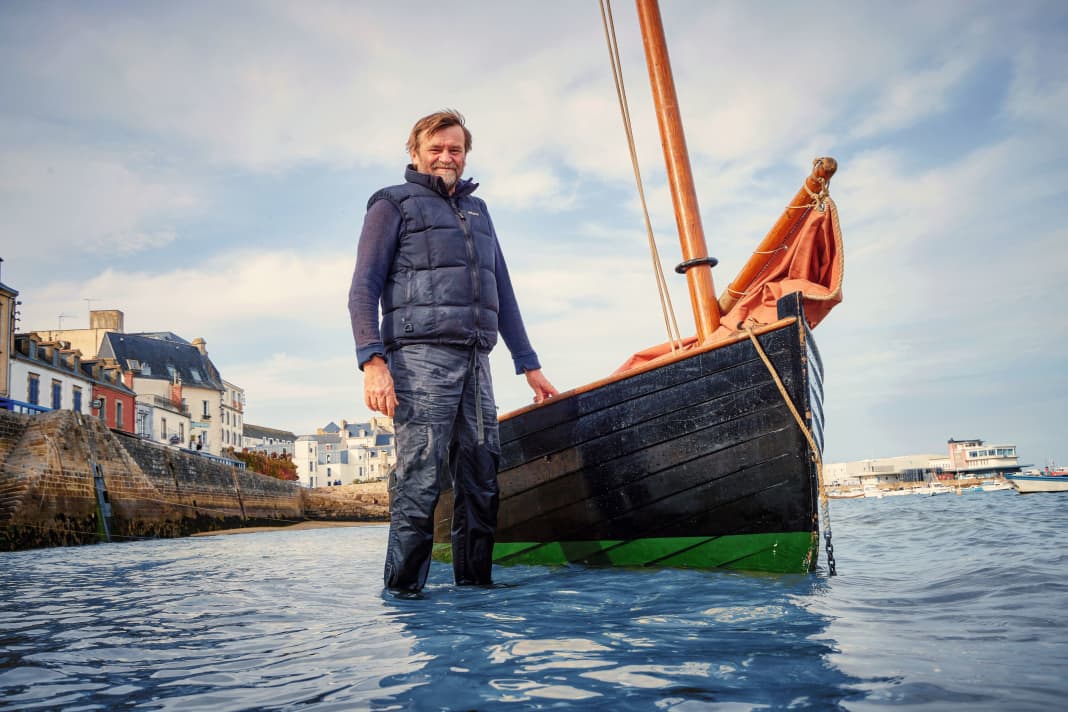





- The tides make every trip an adventure
- Barnes has popularised small boat sailing
- The size of a boat is not a measure of its capabilities
- Real sailing with a seaworthy dinghy
- No marinas or anchorages, but much faster in the pub
- The Ilur used to be a fisherman's tool
- François Vivier revitalised the boat class
- Technical data "Avel Dro"
Far off the coast, amidst the play of the waves, a small reddish-brown dot is visible, moving slightly up and down and slowly towards land. A sailing yacht, perhaps, moving into a quiet bay or the nearest harbour with the help of the strong south-westerly wind. Actually nothing special on the Atlantic coast of Brittany, boats and yachts characterise the landscape here and have always been an important part of the regional identity.
The boat seems tiny in the vastness of the sea
The small brown dot has now emerged just below the coast and is now clearly recognisable as a sail, with a black hull with little freeboard underneath. A small dinghy, with a man at the tiller. In the vastness of this watery world, the boat looks tiny and fragile. Especially as this is not just any salty water lapping at the cliffs and beaches, this is the rough and capricious edge of an ocean and the gateway to the Bay of Biscay. The undisguised admiration among skippers is that anyone who learns the craft of sailing here can hold their own on all the world's oceans.
"It was a fantastic trip today, with plenty of wind from the right side. I just had to make sure I got the waves right." Roger Barnes has just come from the Baie de Douarnenez and has now entered the Breton harbour of the same name, a historic fishing and trading port on a bay south of Brest. He is wearing a brown salted leather hat, blue sailing trousers and a quilted waistcoat with an integrated lifejacket over his rigging shirt. He ties his small boat to the large heavy ring at the top of the quay wall, where the tide will rise at least another five metres in a few hours.
Today it was the Baie de Douarnenez, other favourite destinations for the 61-year-old are the bird island Île de Moutans, where he likes to anchor, or a trip to the car-free Île de Seine. If it's too windy outside, he sails south-west of Brest through the river delta up the Aulne and far inland until the tide sets him down on a sandbank.
The tides make every trip an adventure
Barnes' eyes are narrowed into slits to protect him from the glaring sun, every wrinkle on his forehead tells a story. "It's always an adventure to sail with the strong tidal currents in this area, where fishermen, lighthouse keepers and smugglers travelled in just such small boats over 100 years ago."
The Briton is known in the global small boat scene for his gripping reports on ambitious trips in open dinghies. His example has motivated many people to take up sailing. Or to switch from a large to a small boat and even swap 40-foot yachts for a four-metre dinghy.
Barnes has popularised small boat sailing
In England in particular, Barnes has helped the small boats to achieve unimagined greatness and helped to establish and expand the Dinghy Cruising Association there. "The friendly club with a sense of adventure. For all sailors who use boats for more than just racing," is written in the statutes of this association, which has had Roger Barnes as its president for more than 30 years.
And as Barnes is doing a good job there, it will probably stay that way for the time being, even though he has turned his back on his homeland. The self-confessed Brexit refugee has still not forgiven the captains in Westminster for drifting out of the European Union.
His new home harbour is now here, in the small Breton town of Douarnenez. Ham and eggs with black tea was yesterday, today he has breakfast of pain au chocolat and coffee in "An Ifern", the Breton name for hell. His new home and the architecture firm he runs are also not far from the harbour.
The harbour of Douarnenez is storm-tested. A bulwark against the Bay of Biscay. The quay walls have withstood the raging sea for centuries and rise up like a fortress at low tide.
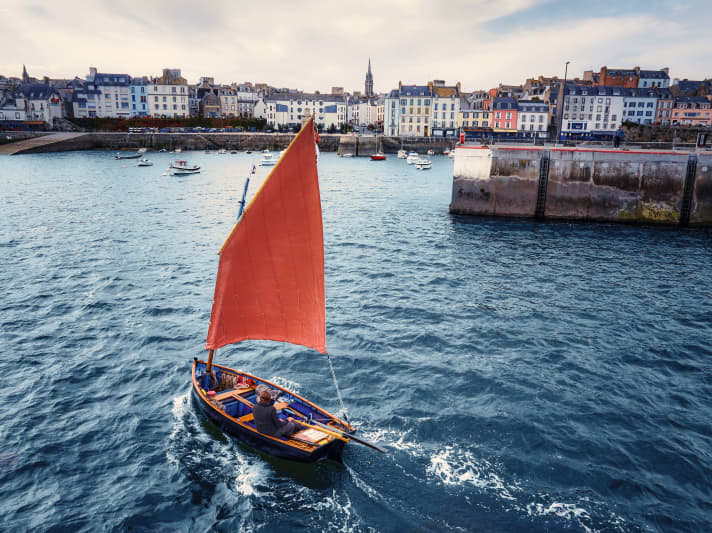
The size of a boat is not a measure of its capabilities
Barnes climbs up the iron ladder rung by rung. Seaweed and shells fall into the harbour basin, the harvest of the last tide. When the burly sailor reaches the top, his posture and facial expression reveal a man of determination and courage. A spiky beard on his weather-beaten face, a look like the piercing beam of a beacon at night. He could easily be mistaken for a captain walking off the gangway of a British frigate after a victorious battle.
In fact, Barnes has just climbed out of his wildly rocking dinghy. A contrast he is royally pleased about. Because he is certain of one thing: the size of a boat is not a measure of the possibilities it offers.
"Look around the marinas, they look like car parks for boats. Hundreds of yachts, tied up to piers and floating jetties, supplied with shore power, equipped and big enough to start a round-the-world voyage tomorrow. But in reality, these ships are usually only sailed short distances and for a few weeks - a year!"
Real sailing with a seaworthy dinghy
Barnes, on the other hand, favours a change of perspective. His simple formula is the result of decades of dinghy cruising practice: as little material as necessary for as maximised an experience as possible. "A lot of time and money is spent on yachts that are crammed with electronics and a powerful engine that then pushes the boat to the harbour of destination when there is a calm or headwind. There's hardly any time for actual sailing, as the alarm clocks of working people start ringing again on Monday mornings."
As little material as necessary for the best possible experience
Barnes lets his gaze wander over the marina. "People who want to get away from it all and sail around the world for years, take a sabbatical at sea or cross the Atlantic non-stop live at the other extreme. But who can afford that?" he asks. "What about ordinary people who have families with schoolchildren and have to go to work every day?"
The answer to the question of how it is possible for the average wage earner to experience some time out, relaxation and adventure on the water, he gives without being asked: "With a seaworthy dinghy." Because that makes it possible to get out on the water quickly on an afternoon, a weekend or on holiday. Even with a small budget and little time. Barnes' message is like his idea of sailing: simple.
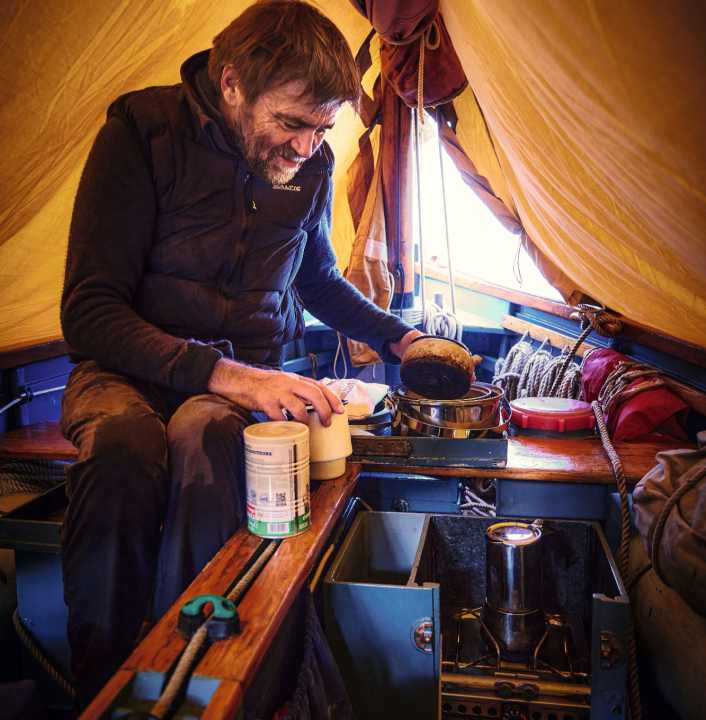
No marinas or anchorages, but much faster in the pub
Roger Barnes is a good narrator. His northern English accent comes out of his throat with an edgy edge, and his insistent words are accompanied by gesticulating arms. "It's not far from the garage to a little sailing adventure, the trailerable dinghy is ready to sail in no time." Other advantages: discovering secluded micro-regions, sailing shallow bays and rivers and landing directly on a beach to spend a quiet night. "We dinghy sailors don't need marinas or deep anchorages and are therefore much quicker in the pub - with plenty of time before the 'last order'," smiles the exiled Brit.
It's not far from the garage to a little sailing adventure, the trailerable dinghy is "ready for sea" in no time at all
The 61-year-old learnt to handle small boats by playing. Barnes spent his childhood in the Lake District in northern England, where he spent every day sailing in a dinghy.
His parents, his mother a teacher and his father a textile artist, supported their son in his nautical urge to move. During the holidays, the whole family travelled through England and France in a small car. They stayed in tents on the beach or on campsites at a time long before the outdoor and motorhome craze swept across the country and the coast.
"My childhood on the lakes and travelling with my family led me to this wonderful open water world at an early age," says Barnes. The adventure novel "Swallows and Amazons" by Arthur Ransome also inspired Barnes and his entire generation. The book tells of the summer of 1929 in the Lake District and the adventures of two children's families who sail, camp, fish and experience life as pirates on an island. "Exactly the life I still lead today," says Barnes deadly serious. And after a short pause, the master of British humour grins all over his face.
The Ilur used to be a fisherman's tool
For this "pirate life", he bought a second-hand Ilur ten years ago, a replica of a traditional Breton coastal fishing vessel. A small, robust dinghy from the early years of the last century. This type of boat was used as an everyday vessel and workboat in the region - cheap to build, robust and agile. Fishermen used it to sail to the mussel banks or fish with trawl nets, lighthouse keepers and pilots were transferred with it, and light freight was transported to the islands or inland. An all-rounder for rowing, rigging and sailing. The hull was usually clinker-built and there was no shelter to keep the crew dry.
Hardly any of these workboats survived, the use in the rough waters was too tough and the wood used was too inferior. When larger boats came along and the fishing grounds were relocated, they fell into oblivion, rotted or fell victim to the flames.
The former owners of these dinghies had no personal interest in preserving their old boats. They had experienced neither relaxation nor adventure on their planks. Rather, their time on board had been spent procuring food and transport - and all too often it had been a naked struggle for survival in a sometimes inhospitable environment.
François Vivier revitalised the boat class
More than a hundred years had to pass before yacht designer François Vivier, an expert in the revival of traditional sailing and rowing boats, set about reconstructing the small boats of his homeland. In his office in Pornichet near Nantes, he used photographs, paintings and historical texts to reconstruct one of the Breton workboats of yesteryear, which left the drawing board in 1989 as the "Ilur" and is now a tried and tested sailing dinghy that has been built hundreds of times over.
The plywood hull is clinkered, extended and widened by 20 centimetres and has more freeboard than the original. A new feature is a centreboard, which makes it possible to sail upwind in a sensible manner where previously it was only possible to gain windward with rudders and rigging.
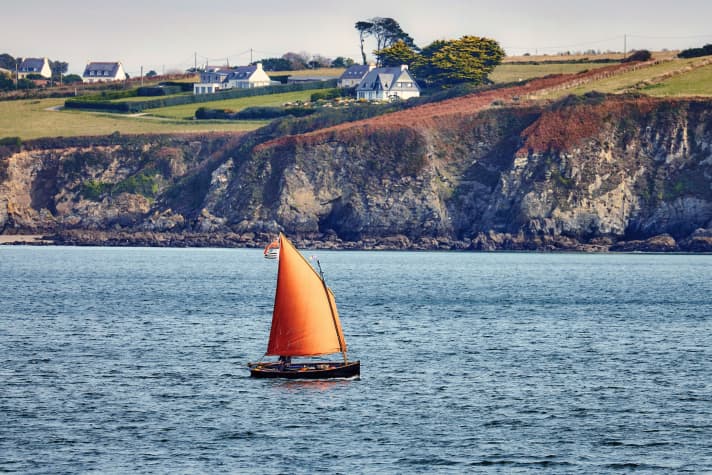
The reefable lugger sail is sailed without a boom, the sheet hole points are hooked aft to the upper transom on the windward side. The mast is only held in position by a rope and can be hoisted in just a few moments.
"A budget of around 2,000 euros is enough for a second-hand boat, including trailer," says Barnes. If you are confident enough to build it yourself, you can obtain the construction drawings from François Vivier's web shop.
A story about the Ilur became Barnes' personal story
Barnes, who has owned dozens of dinghies and yachts, found the wooden love of his life quite by chance. As a columnist for a sailing magazine, he had travelled to the boat show in Morbihan in search of a topic. The Ilur, designed by Vivier, was moored there. Barnes immediately spotted the potential for a story - which would soon become his own personal story.
After just a few test strokes, Barnes was immediately convinced that he had discovered the ideal riding dinghy for himself. And so, a little later, he bought a second-hand Ilur from an officer in the French cavalry. "Until then, the family of five used the boat for weekend and holiday cruises. But when more children arrived, the owner found it too cramped on board," says Barnes, grinning: "Not even the CE standard can provide better proof of safety."
As "Avel Dro", Breton for whirlwind, he sailed his boat many hundreds of miles, initially on home waters. He travelled England's lakes, rivers and coastal areas. And with trips to the lagoons of Venice and the canals of Holland, Barnes later proved impressively how versatile the choice of sailing areas can be with a trailerable small boat.
Everything but boredom
In addition to picture-perfect experiences such as falling dry in bays, surfing tidal waves in narrow rivers and landing and camping on deserted beaches, the Salzbuckel also had to master some horror scenarios. Weathering storms and swells between steep cliffs, escaping thunderstorms and provoking a capsize to prevent an accident on the coast - it's almost impossible to recount everything. "The only thing I was spared was boredom."
Barnes is the undisputed spiritus rector in the global dinghy community. In addition to his activities with the Dinghy Cruising Association, he is also present on social media and runs a successful YouTube channel with almost 40,000 subscribers. His most popular post about a trip on the Thames has been viewed more than 600,000 times. Whether it's travel reports, technical details about equipment, building a cooking box, navigation et cetera - with his expertise, distinctive narrative style and British humour, he captivates experts and novices alike and gets them on board in the truest sense of the word.
In the meantime, dusk is falling over Douarnenez and the tide has already risen high at the stone slip. Roger Barnes has carefully manoeuvred his "Avel Dro" onto the trailer, lashed it down and laid the mast. After less than 20 minutes, it is ready to go. What is the secret recipe that enables the 61-year-old to manage the workload of gainful employment and lobbying while also writing books, making films and painting pictures? "Dinghy cruising" is the answer. What else?
Technical data "Avel Dro"
Breton dinghy type Ilur
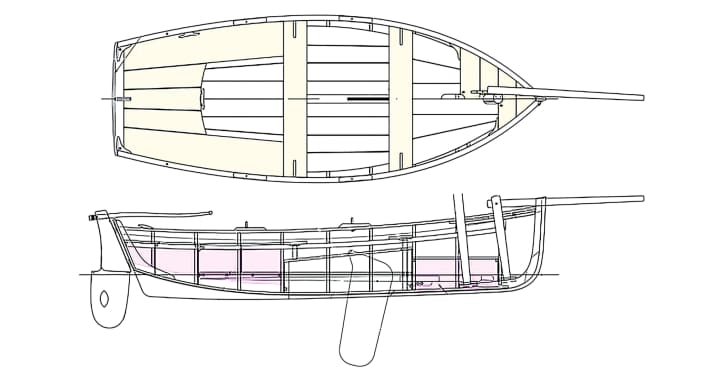
- Designer: François Vivier
- Material: Plywood
- Length: 4,44 m
- Width: 1,70 m
- Depth: 0,25/0,86 m
- Weight: 350 kg
- sail area: 12.2 square metres
- www.vivierboats.com
Bible for dinghy fans
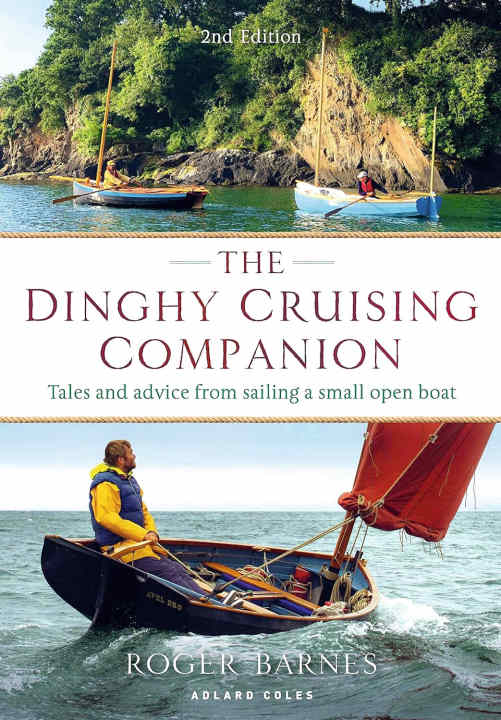
Roger Barnes' publications on his lovingly designed website and in specialist magazines are numerous. He is a sought-after interview guest and author of "The Dinghy Cruising Companion" - the standard work in this genre, which is currently in its second edition. Barnes is currently writing a new book entitled "Sailing the Shallows". Naturally, it will also deal with cruising in a simple dinghy. Barnes also wants to report on his positive experiences of integrating sailing into everyday life and "not making a big deal out of it".
"The Dinghy Cruising Companion" is published by Adlard Coles and costs 24.30 euros in paperback, weblink: www.rogerbarnes.org

